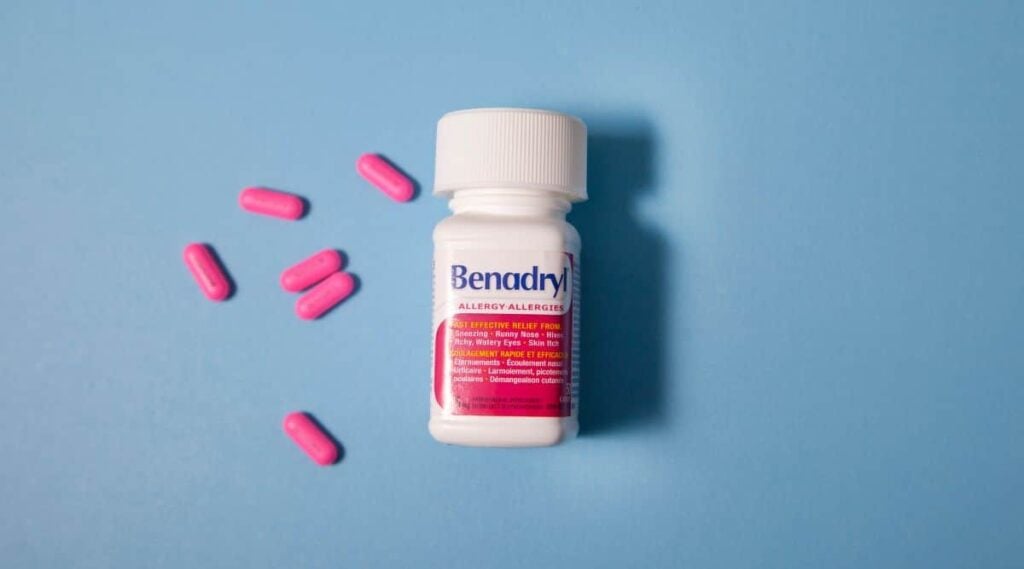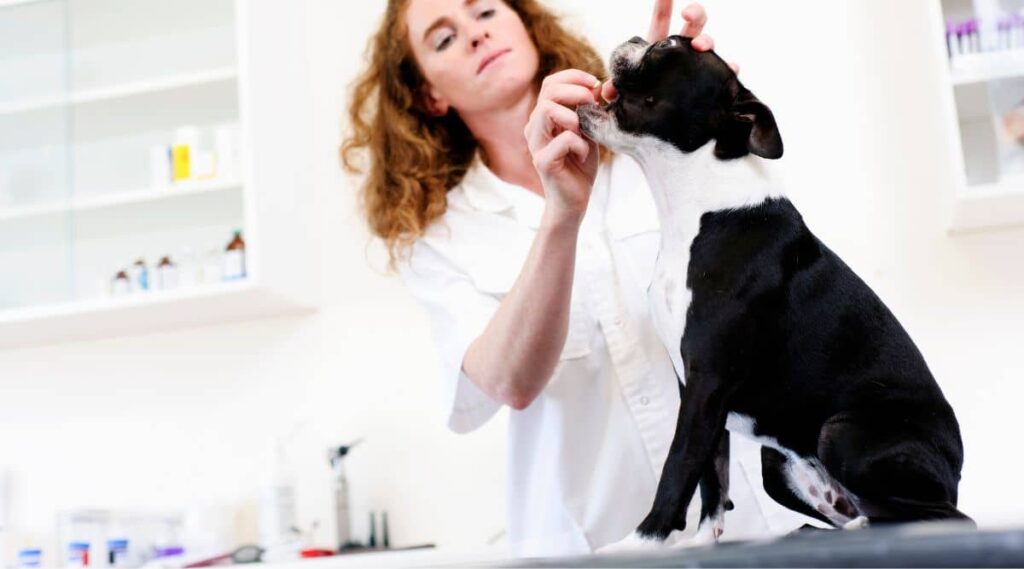Can Dogs Have Benadryl?
When you purchase through links on our site, we may earn a commission. Here’s how it works.
With the rising cost of living these days, it can be extremely tempting to try to treat your dog at home to avoid a potentially costly trip to the veterinary clinic.
This, however, is extremely dangerous. Dogs do not process medication the same way we do. Some of our seemingly safe over-the-counter drugs can cause fatal reactions in our canine companions.
It is essential to consult your veterinarian before reaching for human medication for your pup. Let’s take a look at Benadryl and its use in veterinary medicine. And it is important to note that Benadryl is not the same in all countries. This article focuses on diphenhydramine, the formulation that is used in the United States and Canada.
Table of Contents
What Is Benadryl?

In the US, Canada, Singapore, Taiwan, Italy, and Hong Kong, the active ingredient in “American Benadryl” is diphenhydramine hydrochloride, so we will focus on this formulation.
In the UK and Denmark, however, the active compound is acrivastine in Benadryl Allergy Relief and cetirizine in Benadryl Once a Day. Limited information exists on acrivastine and cetirizine use in dogs, so if you are in Europe, check the active ingredient to make sure it is diphenhydramine, the only Benadryl that is considered safe for dogs.
To avoid confusion, I will use the drug’s generic name, diphenhydramine, in this article.
Diphenhydramine is a type of antihistamine that can cross the blood-brain barrier. This increases its efficacy but also means there is an increased risk of potential side effects. Antihistamines are a class of medications used in veterinary medicine to treat allergic reactions, motion sickness, and even vomiting. They can also help with anxiety, have mild sedative properties, and are one of the therapies used to treat a type of tumor called a mast cell tumor. Antihistamines work by blocking the body’s receptors for naturally produced histamines. While your dog still produces these histamines, the body does not respond to them as much when they have taken an antihistamine.
The FDA does not license diphenhydramine for veterinary use, so when your veterinarian prescribes it, they are doing so “off-label.” It is considered safe for use in dogs and cats, but only under veterinary guidance.
How Is Benadryl Given To My Dog?
Diphenhydramine formulations come in liquids, tablets, and capsules. These are to be given by mouth. They can either be given on an empty or full stomach, but if your dog shows signs of feeling sick or is sick, it is best to give their next dose with some food.
In the hospital setting, an injectable form of diphenhydramine may be used. This is usually given either via the vein or into the muscle, depending on how quickly your veterinarian needs the drug to work. In emergency settings, such as severe allergic reactions, the best way to administer an antihistamine is via injection, as it will work fastest this way.
Slow-release formulations of diphenhydramine should never be given to your dog. Their absorption profile may be different from humans. Also, there is the risk of your pup chewing the capsule, leading to an overdose. As a pet parent, caution should be taken with liquid formulations as the dosages per ml volume may vary. They can also contain sweeteners such as Xylitol which can be fatal if ingested by your dog.
When Might My Veterinarian Prescribe Benadryl?
Diphenhydramine has several applications in veterinary medicine, and while this list is not exhaustive, we will consider a few of these below:
Allergies
When your dog has an allergic reaction to something, the body produces histamines in response. Histamines are a type of chemical involved in your dog’s immune response to perceived allergy threats (such as pollen, bee stings, or snake bites, for example). While histamines serve a vital role in several body systems, too much of them can lead to allergy responses. Common signs include itchiness, sneezing, and hives. In extreme cases, they can lead to swelling, and when this happens in the airways, it can be fatal.
Antihistamines can play an important role in managing allergic disorders, such as allergic skin disease, in dogs. Suppose your pet has suspected skin allergies and is having diagnostic investigations performed. In that case, they mustn’t be currently taking antihistamine medications, such as diphenhydramine, as this may lead to inaccurate test results. Antihistamines are also a vital first-line therapy if your dog suffers from a severe anaphylactic allergic reaction.
Nausea, Vomiting, and Motion Sickness
Feeling nauseous and vomiting happens via very complex mechanisms. Part of the process, especially in motion sickness, is thought to be mediated by a particular type of histamine receptor, the “H1 histaminergic receptors”. Antihistamines such as diphenhydramine work by blocking the histamine receptors. Therefore diphenhydramine has been used in dogs to help with nausea and as a motion sickness treatment. Your veterinarian will usually advise giving the medication 30-60minutes before your pet travels to allow it time to work.
Anxiety
Owing to its potential to cause mild sedation, diphenhydramine is sometimes prescribed to help dogs that suffer from anxiety disorders. While this can be temporarily beneficial in mild cases, it is crucial to ensure you are working with a veterinarian or licensed behaviorist to address the root cause of your pup’s anxiety rather than just sedating her. A holistic behavioral strategy, not just the use of medication, is more likely to result in a successful outcome.
Mast Cell Tumours
Mast cell tumors are a type of cancer. Mast cells are a type of immune system cell involved in the body’s response to certain bacteria, viruses, and allergens. They also have a role in the control of other immune responses. As part of their normal function, mast cells release histamines. A mast cell tumor contains many cancerous mast cells (essentially, they replicate uncontrollably because of a loss of safety mechanisms).
If bumped or handled, the mast cells can “degranulate’, where they release their histamine contents into the body. This can lead to local tumor swelling in small amounts, but in severe cases, the signs can mimic an anaphylactic reaction. Dogs with mast cell tumors can also experience more chronic inflammatory symptoms due to increased circulating histamines. If your pet has a mast cell tumor, your veterinarian may advise using diphenhydramine as part of their cancer treatment program.
What Problems Might My Dog Have With Benadryl?

Diphenhydramine use can be associated with several different side effects. The most common side effects include lethargy, urinary retention, reduced saliva, and drowsiness. Your dog may also show signs of rapid breathing or increased heart rate. Other less common side effects include gastrointestinal upset and changes in appetite. Usually, these side effects will be seen within one hour of your pet ingesting the medication.
When Might Benadryl Be Risky?
Diphenhydramine should not be used in pets with allergies to this drug or similar antihistamine medications. It should not be used in young puppies unless under direct veterinary guidance. Dogs with medical conditions such as glaucoma, prostatic disease, intestinal or bladder obstructions, hyperthyroidism, heart disease, seizure disorders, allergic lung disease, or high blood pressure should only use this medicine under direct veterinary instruction.
Your veterinarian will also prescribe this medication cautiously in pregnant or lactating dogs as it has been shown to cause birth defects in laboratory animals and be excreted in milk. Elderly animals or working dogs are also groups where the use of these medications should be undertaken cautiously.
An important thing to remember is that “Benadryl” is a brand name and many products exist under its umbrella. Some of these products can contain additional medications or compounds that may be toxic to your pet, such as acetaminophen (dogs can tolerate much lower doses than us, and this drug is highly toxic to cats). Generic diphenhydramine products can also contain additional drugs or compounds. Therefore, it is never safe to assume a product is safe to give to your pet without checking first with your veterinarian.
What Should I Do If My Dog Has Overdosed on Benadryl?
If you think your dog has had an overdose of Benadryl, you should contact your local veterinarian or their emergency out-of-hours provider as soon as possible. Signs of a potential overdose include:
- Agitation
- Aggression
- Lethargy or sedation
- Vomiting, diarrhea, or constipation
- Dilated pupils
- Seizures
- Changes to breathing and heart rate
- Death
If you have witnessed your pet ingest this medication accidentally or inadvertently given too much, do not wait for them to show signs of toxicity. It may then be too late to administer effective treatment. Although counterintuitive, some dogs can even have an allergic reaction to this medication. If you suspect this is happening to your dog, contact your veterinary care provider immediately. This emergency poisoning checklist can be helpful too.
Are There Any Medications That Should Not Be Given Alongside Benadryl?
If your dog takes any medications regularly, you must discuss giving diphenhydramine with your veterinarian. Equally, if you give your pup diphenhydramine and she needs to visit the veterinary clinic and receive treatment, you must tell your veterinarian about it. This is because diphenhydramine can have harmful interactions when given alongside certain drugs, making them riskier for your pup. Examples include tricyclic antidepressants, some pain medication, sedatives, or anesthetics.
Final Thoughts
Under veterinary guidance, Benadryl for dogs requires precise dosing and caution, as overdoses can be life-threatening. It is always recommended to speak to your veterinarian before giving your pup any human medications. Certain over-the-counter human drugs that we would consider very safe to use are, in fact, toxic to dogs. Also, due to their different metabolism, drug doses are very different in dogs compared to people.
If you are a UK-based reader, the formulation of Benadryl contains a drug that you should not give to your dog. Never assume that a human drug is safe for your dog unless you have first spoken to your veterinarian. This way, you can be sure you aren’t putting your pup at risk.



